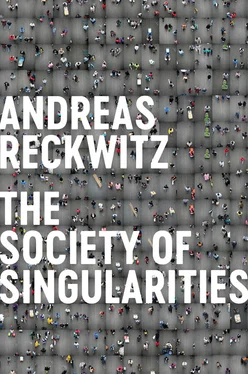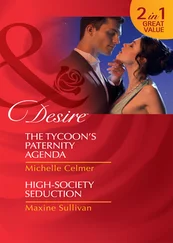For the new middle class, culture has come to acquire the form of hyperculture , which is altogether characteristic of late modernity. In the case of hyperculture, potentially everything past or present can flexibly be valorized as culture. Be it high or low culture, local or global, contemporary or historical – all potential elements of culture are essentially on equal footing and are regarded as potential sources for enriching one’s lifestyle. Hyperculture is distinguished by its cultural cosmopolitanism, within whose framework the elements of culture can be combined in seemingly endless ways. Uniqueness thus tends to derive from the model of compositional singularity : it is forever being arranged and curated from a diverse set of new and ever-changing elements. In fact, it is this compositional logic that enables late-modern culture to fabricate singularities on a mass scale.
The society of singularities has systematically created a series of new social and cultural polarizations , and these will be discussed at length in the following Part. It is important to keep in mind that these polarizations are not ancillary or accidental features but rather a direct consequence of the logic of singularization leaving behind social niches and becoming structurally formational for all of society. They are the result of society evaluating what counts as valuable and unique. It is here where processes of valorization and devaluation occur that are definitive of late-modernity. Five different levels can be distinguished:
The basic level is that of the polarization of goods on the markets of singularity, which is the precondition for all other polarizations. As markets of attention and valorization, singularity markets tend to form radically asymmetrical patterns. They are winner-take-all markets in which a few goods attract extreme amounts of attention, visibility, and value, while most goods achieve nothing of the sort. Cultural singularity markets are thus inclined to award things in excess and disregard other things entirely.
This is reflected on a second level: the polarization of working conditions , which has two aspects. Essentially, a dualism now exists between the highly qualified activities of the knowledge and culture economy on the one hand, and the simple or standardized activities of the service sector on the other. In late modernity, the professions that produce cultural singularity goods can claim legitimacy, status, and resources, whereas functional and “profane” labor cannot. What is more, tendencies toward polarization exist within the field of highly qualified professions. This field itself has adopted the features of a cultural singularity market on which performances, profiles, talent, and their recognition circulate, and this leads in its own way to the asymmetry of a winner-take-the-most market.
Third, all of this has given rise to a polarization of classes and lifestyles . The latter applies in particular to the relationship between the culturally ascendant new middle class on the one hand, and the culturally declining new underclass on the other. Whereas the new middle class can be understood as the cosmopolitan basis of culturalization and singularization processes, the new underclass has been socially and culturally devalued. Beyond the leveled middle-class society, this has thus resulted in more or less subtle cultural conflicts and tendencies toward segregation that affect such things as education, living conditions, and health.
Fourth, the polarization of goods, labor, and lifestyles has led to a polarization of social spaces . Regional, national, and global markets of spatial attractiveness have formed, and these have led to diverging developments in “attractive” places and regions that are said to have been “left behind.” Whereas the former house the creative economy and the new middle class, the latter face the threat of being devalued altogether.
Finally, a political polarization has taken place in late modernity that can be interpreted as a reaction to the other levels of polarization. On the one hand, there is an “apertistic” (opening) and differential (difference-promoting) liberalism that is based on a combination of competition and cultural diversity. On the other hand, there is a slew of anti-liberal, (sub)political forms of cultural essentialism and communitarianism (ethnicity, nationality, religious fundamentalism, right-wing populism) that have mobilized collective identities against the hyperculture and its markets. Of course, these identity movements operate within the logic of the society of singularities. They, too, are based on a culture of singularity; however, theirs does not function on global markets but is rather situated within particular collectives (religious, national, ethnic, etc.). As a result of this polarization, the society of singularities is characterized throughout by cultural conflicts.
1 Social-theoretical interpretations of archaic societies are controversial. For antipodal views, see Deleuze and Guattari, A Thousand Plateaus, which stresses the aspect of idiosyncrasies, and the third chapter of Talcott Parsons’s Societies: Evolutionary and Comparative Perspectives (Englewood Cliffs, NJ: Prentice Hall, 1966), which focuses primarily on collectivism. 2 Consider, for example, the openness with which transgender persons are treated in native American societies. See Sue-Ellen Jacobs et al., eds., Two-Spirit People: Native American Gender Identity, Sexuality, and Spirituality (Urbana: University of Illinois Press, 2005). 3 See Durkheim, The Elementary Forms of Religious Life; Michel Leiris, Ethnologische Schriften I: Die eigene und die fremde Kultur, ed. Hans-Jürgen Heinrichs (Frankfurt am Main: Suhrkamp, 1985); and Turner, The Ritual Process. On totemism, see also Claude Lévi-Strauss, Totemism, trans. Rodney Needham (London: Merlin Press, 1964). 4 On traditional religious systems, see Max Weber, The Sociology of Religion, trans. Ephraim Fischoff (Boston, MA: Beacon Press, 1999); and Helmut von Glasenapp, Die fünf Weltreligionen (Cologne: Dietrichs, 1985). On courtly cultures, see Norbert Elias, The Court Society, trans. Edmund Jephcott and Stephen Mennell (New York: Pantheon, 1983). On folk culture, see Mikhail Bakhtin, Rabelais and His World, trans. Hélène Iswolsky (Bloomington: Indiana University Press, 1984). 5 This is a multifaceted topic. See, for instance, Jan A. Aersten and Andreas Speer, eds., Individuum und Individualität im Mittelalter (Berlin: De Gruyter, 1996). 6 See, for example, Gottfried Kerscher, Architektur als Repräsentation: Spätmittelalterliche Palastbaukunst zwischen Pracht und zeremoniellen Voraussetzungen (Tübingen: Wasmuth, 2000). 7 See Chapter 1 in this Part. 8 See Manfred Hettling, “Bürgerliche Kultur: Bürgerlichkeit als kulturelles System,” in Sozial- und Kulturgeschichte des Bürgertums, ed. Peter Lundgreen (Göttingen: Vandenhoeck & Ruprecht, 2000), pp. 319–40; Thomas Nipperday, Wie das Bürgertum die Moderne fand (Stuttgart: Reclam, 1998); and Dieter Hein and Andreas Schulz, eds., Bürgerkultur im 19. Jahrhundert: Bildung, Kunst und Lebenswelt (Munich: Beck, 1996). 9 See the second chapter of Reckwitz, The Invention of Creativity, as well as Pierre Bourdieu, The Rules of Art: Genesis and Structure of the Literary Field, trans. Susan Emanuel (Stanford University Press, 1996); and Oskar Bätschmann, Ausstellungskünstler: Kult und Karriere im modernen Kunstsystem (Cologne: DuMont, 1997). 10 See Georg Bollenbeck, Bildung und Kultur: Glanz und Elend eines deutschen Deutungsmuster (Frankfurt am Main: Suhrkamp, 2001). 11 See Reckwitz, Das hybride Subjekt, pp. 204–30; Lothar Pikulik, Romantik als Ungenügen an der Normalität: Am Beispiel Tiecks, Hoffmanns, Eichendorffs (Frankfurt am Main: Suhrkamp, 1979); Gerald N. Izenberg, Impossible Individuality: Romanticism, Revolution, and the Origins of Modern Selfhood, 1787–1802 (Princeton University Press, 2001); Isaiah Berlin, The Roots of Romanticism, ed. Henry Hardy (Princeton University Press, 2014); and Taylor, Sources of the Self, pp. 368–92. 12 See Eric Hobsbawm, Nations and Nationalism since 1780: Program, Myth, Reality (Cambridge University Press, 1992); and Benedict Anderson, Imagined Communities: Reflections on the Origin and Spread of Nationalism, 2nd edn. (London: Verso, 1991). Regarding Asia in particular, see Pankaj Mishra, From the Ruins of Empire: The Revolt Against the West and the Remaking of Asia (London: Penguin, 2012). 13 See T. J. Jackson Lears, Fables of Abundance: A Cultural History of Advertising in America (New York: Basic Books, 1993); and Janet Ward, Weimar Surfaces: Urban Visual Culture in 1920s Germany (Berkeley: University of California Press, 2001). 14 See Georg Simmel, “Fashion,” The American Journal of Sociology 62 (1957), pp. 541–8. 15 See Michael Makropoulos, “Massenkultur als Kontingenzkultur,” in Lautloses irren – Ways of Worldmaking Too …, ed. Harm Lux (Berlin: Harm Lux, 2003), pp. 151–73. 16 For further discussion of this phenomenon, see Reckwitz, Das hybride Subjekt, pp. 409–40. On consumption and imitation, see Whyte, The Organization Man, pp. 312–14. 17 In their book Dialectic of Enlightenment, however, Adorno and Horkheimer reduced the cinematic film to a place in which the commercial logic of the general could operate. 18 See Edgar Morin, The Stars (Minneapolis: University of Minnesota Press, 2005). 19 The “new middle class” has been analyzed from a number of different theoretical perspectives. From the perspective of the knowledge society, see Daniel Bell, The Coming of Post-Industrial Society: A Venture in Social Forecasting (New York: Basic Books, 1973); or Peter Drucker, Post-Capitalist Society (New York: Harper Business, 1994). From the perspective of post-Fordism, see Lazzarato’s essay “Immaterial Labor,” and Yann Moulier Boutang, Cognitive Capitalism, trans. Ed Emery (Cambridge: Polity, 2011). 20 See Ronald Inglehart, The Silent Revolution: Changing Values and Political Styles Among Western Publics (Princeton University Press, 1977); Paul Leinberger and Bruce Tucker, The New Individualists: The Generation After the Organization Man (New York: Harper Collins, 1991); and Daniel Bell, The Cultural Contradictions of Capitalism (New York: Basic Books, 1976). Recently, the transformation of values that has taken place in Germany has been empirically confirmed yet again – see Jutta Allmendinger, Das Land, in dem wir leben wollen: Wie die Deutschen sich ihre Zukunft vorstellen (Munich: Pantheon, 2017). 21 See Michael Piore and Charles Sabel, The Second Industrial Divide: Possibilities for Prosperity (New York: Basic Books, 1984); and David Harvey, The Condition of Postmodernity: An Enquiry into the Origins of Cultural Change (Oxford: Blackwell, 1989), pp. 121–200. 22 See Paul E. Ceruzzi, A History of Modern Computing (Cambridge, MA: MIT Press, 2003). 23 See Marion von Osten, ed., Norm der Abweichung (Zurich: Edition Voldemeer, 2003).
Читать дальше












